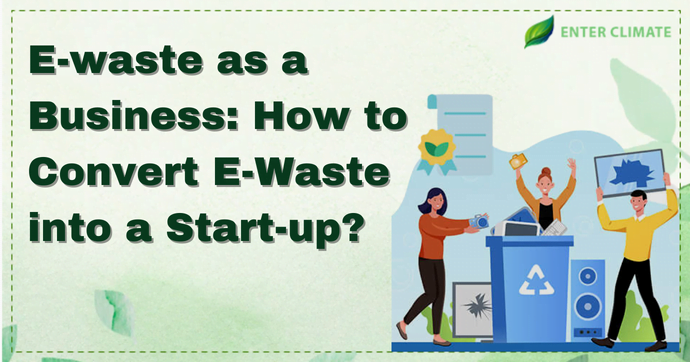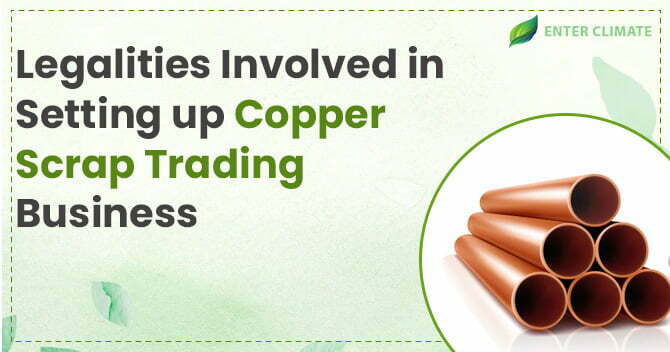E-waste as a Business: How to Convert Electronic Waste into a Start-up?
 12 Oct, 2022
12 Oct, 2022 
During the time of Covid, technology and EEE (Electrical and Electronic Equipment) have seen tremendous growth with an influx of new gadgets every day in the market. But with this development of the digital era, e-waste also started accumulating with no proper management system in place. Thus, the need for e-waste as a business was felt.
According to the Central Pollution Control Board’s (CPCB) latest reports, India generated over 7.71 lakh tonnes in 2018–19, up from 10.14 lakh in 2019–20, representing at least a 31 per cent gain. These wastes are produced from many different sources, including but not limited to households, individual consumers, and bulk consumers, which include governmental institutions, commercial organisations, producers and retailers.
With this generation of electronic waste, the Government of India (GOI) and its respective authorities have taken many steps to promote e-waste as a business. This not only develops the country’s economy but will create more jobs and maintain a sustainable environment. The International Finance Corporation (IFC) estimates that by 2025, India’s electronic waste business will generate 4.5 lakh direct jobs and an additional 1.8 lakh jobs in related manufacturing and transportation-related industries. Furthermore, if we use the USA as an example, e-waste management caused 757,000 jobs, $6.7 billion in tax income and $36.6 billion in pay. Lastly, recycling results in the creation of various jobs, the payment of $76,000 in wages, and the collection of $14,101 in taxes for every thousand tonnes recycled.
Opportunity in case of E-waste as Business
- Even after being discarded, E-waste remains a valuable asset that can be further refurbished or dismantled to extract the precious metal. These can be channelled to Original Equipment Manufacturers or authorised refurbishers as raw materials. Manufacturers looking for e-waste as a business can start a dismantler facility with the prospect of turning it into a lucrative business.
- India is among the highest producers of e-waste, after China and the United States of America.
- With the increase in the demand for EEE, there is a considerable prospect for an increase in the refurbishing and recycling business involved in e-waste.
Metals that can be extracted from electronic waste
Electronic waste is considered a goldmine when it comes to the economy due to the present precious metals in it.This can be further used to create more revenue for the country. Thereby creating a massive market for e-waste as a business. Some of the metals that can be extracted from e-waste are: –
|
Electronic waste products |
Metals recovered after recycling the products |
|
Connector plating is usually used in computer equipment |
Gold |
|
Nickel-cadmium batteries |
Nickel |
|
Lithium-ion batteries |
Lithium |
|
Coatings on component leads, Solder |
Tin |
|
All electronic devices using a few watts of power |
Aluminium |
|
Transistorised electronics |
Germanium |
|
Plating for steel parts |
Zinc |
|
Glass, transistors, ICs, printed circuit boards |
Silicon |
|
Printed circuit board tracks, component leads, copper wire |
Copper |
Process of setting up an E-waste recycling business
Even though E-waste as a business seems profitable, it does need substantial monetary assistance in obtaining the license to land and establishing operations. Based on this, there are two categories of e-waste business models: –
- Self-Owned Operation
In this business model, the recycler is the primary stakeholder who has to bear the total cost in case the operation endures any loss.
- Franchised-Based Operation
In this e-waste as a business model, the company’s franchise, which is already formed in an electronic waste management organisation, ignores the waste. Deshwal Waste Management, Deluxe Recycling, Packman and other significant businesses operate as investments in e-waste recycling.
The producers must get a company certificate to set up e-waste as a business.
The documents required for the same are: –
- Applicant’sdetails, along with the address proof
- GST certificate
- Rent agreement of the premise or NOC
- Trade license
- Plan layout
In the case of a company: –
- Certificate of Incorporation
- Corporate PAN card, TIN numbers, GSTIN, etc.
- Memorandum of Association
- Article of Association
- Authorised signatory
Process of setting up a recycling business
Producers/Manufacturers/Importers/Brand Owners (PIBOs)looking forward to establishing e-waste as a business must obtain different licences from the authorised governmental department. These departments may vary from state to state. For acquiring certification, some of the essential requirements are: –
- The recyclers must apply for Udyog Aadhaar MSME Registration through the online portal.
- Once registered, the producers must apply for a “Consent to Establish” Certificate from the relevant State Pollution Control Board. The process includes signing up for the online consent management and monitoring system. This is followed by submitting an application with all the necessary details and undergoing a required inspection.
- In case of e-waste import, the recycler will need permission from the Ministry of Environment, Forest and Climate Change and the Central Board of Excise and Customs[1].
Documents for acquiring Udyog Aadhaar MSME Registration for stating e-waste as a business
- The official name of the applicant
- Name and type of enterprise
- Aadhaar card of the applicant
- PAN card for the official address of the business
- The NIC code
- Account details
- The social category of the applicant
- The business operations of the enterprise
- Date of Incorporation of a business
- Details related to employment
Documents required for “Consent to Establish”
The following documents are required for obtaining CTE for setting up a unit for e-waste as a business –
- Total open land in the industrial complex for Green Belt Development, landscaping, and other purposes
- Site/layout plan with photos portraying the distance between the proposed site, the nearest residential area and the water body (applicable for orange and red categories)
- Building blueprints with machinery details drawn by a capable person
- Small Scale Industry Certificate from Ministry of Micro, Small and Medium Enterprises, Industry Department Certificate
- Vents/stacks/chimney and emission sites with numbers
- The layout plan shows the drainage/pipeline and final disposal point for liquid effluent
- Collection, storage, and disposal of solid waste
- Total constructed area
- Diesel generators specifications
- The report on the process includes production process info, process flow figure, chemical formula emission, effluent, and hazards/solid waste sources.
- Flow diagram and effluent/sewage treatment plant provisions
- Boiler type, fuel used and quantity
- Particulars on air pollution controls
- Raw material list with daily monthly quantity
- Product/by-product list with daily monthly quantity
- Only for healthcare facilities, pharmaceutical units
- Common biomedical waste treatment facility membership letter
- A material safety data sheet (in the case of chemical industries)
- Consent from the state’s groundwater authority
Conclusion
E-waste that is not managed correctly can lead to disastrous results for human health and the environment. Promoting e-waste as a business opportunity will not only solve the issue of environmental pollution. Still, it will significantly contribute to the country’s revenue, ultimately impacting India’s development.
Read our Article: How to draft a detailed E-waste Business Plan?













